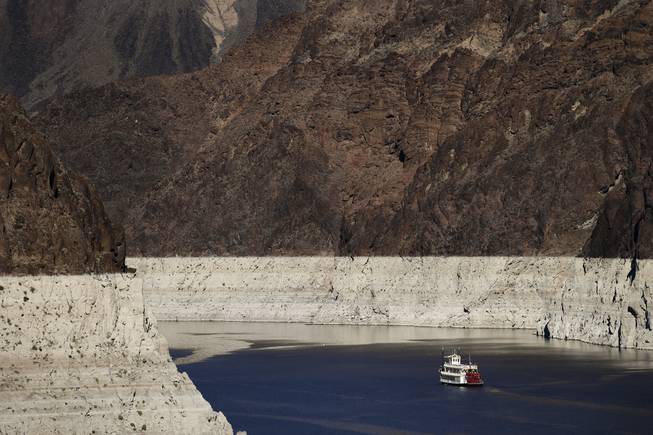
Jae C. Hong / AP
In this Oct. 14, 2015, file photo, a riverboat glides through Lake Mead on the Colorado River at Hoover Dam near Boulder City.
Tuesday, Sept. 6, 2016 | 3:39 p.m.
It sounded too good to be true — an official forecast that 2016 water use in Arizona, California and Nevada will be the lowest since 1992.
That forecast from the U.S. Bureau of Reclamation was too good to be true — by the bureau's own admission. It was widely reported recently as a sign of major progress toward conservation. But what the bureau calls its more accurate forecast, while still showing progress, is significantly higher, predicting water use in the states will be its lowest in 11 years -- not 24.
For those three Lower Colorado River Basin states, the bureau predicts their 2016 total use will be 7.29 million acre-feet of water. That's enough to serve about twice that many homes with water for a year.
The forecast comes from the bureau's monthly study that looks up to 24 months ahead to predict how high Lake Mead and other reservoirs will be in a given month.
It's still good news, the bureau said — about 200,000 acre-feet less water out of Lake Mead this year than the states have the right to take. It's also about 150,000 acre-feet less than the states used in 2015.
That's due to conservation efforts by the three states, bureau officials say. Water officials across the West say the states need to conserve more to keep Lake Mead from dropping so low as to require severe cutbacks in water deliveries, including to Arizona's $4 billion Central Arizona Project that delivers Tucson's drinking water. The lake already has fallen more than 100 feet since 1999 due to drought and a chronic "structural deficit" in which use exceeds supplies even in years of normal runoff.
The other bureau forecast, updated daily, has predicted since late July that the three states will use 6.9 million to almost 7 million acre-feet this year. That's around 500,000 acre-feet less than they have the right to take.
The last year the three states used less than 7 million was 1992 -- the final year of George H.W. Bush's presidency. This lower forecast made news in the Las Vegas Review Journal and on the water news website Circle of Blue as a sign of how much progress the three states are making in conservation.
In a water-oriented blog, Albuquerque-based author John Fleck wrote that the 6.9 million forecast illustrated a central point of his new book, "Water is for Fighting Over": That "when people have less water, they use less water -- that we have the ability to significantly reduce our water use in the arid West and still thrive, and that we are in fact already making significant progress."
But when asked by the Star why the bureau predicted such a dramatic decrease, bureau officials said recently that this forecast is likely to be wrong.
The discrepancy stems from the fact that the agency's two forecasts have different purposes and rely on different assumptions.
The higher-use forecast comes from a study the bureau uses to predict whether it will have to cut water deliveries to states the following year. That study relies on computer models to project future reservoir conditions and potential dam operations. Those models rely on a range of factors, including existing reservoir conditions and forecasts of how much water will flow into the reservoirs and how much the states will take out of them.
The other forecast helps the bureau's staff and water users monitor projected water diversions and use to avoid "overruns," or the diversion of more water than they're allowed to take, said Paul Matuska, water accounting and verifications manager in the bureau's Boulder City, Nevada, office. It's based on the amount of water that users order -- and that the bureau approves -- to be diverted from the river to farms and cities in the three states.
But while the bureau considers the 24-month study forecast more accurate, it's not planning to abandon the daily forecasts. The two forecasts differ slightly during the year, but they'll dovetail by year's end, said Rose Davis, a bureau spokeswoman.
"The two forecasts begin with the same assumptions of water use for the year, but vary in how the changes in water use are recorded or observed," Davis said.
Some Lower Basin users are interested in both sets of data and understand their complexities, she said, although the information can seem confusing at times.

Join the Discussion:
Check this out for a full explanation of our conversion to the LiveFyre commenting system and instructions on how to sign up for an account.
Full comments policy